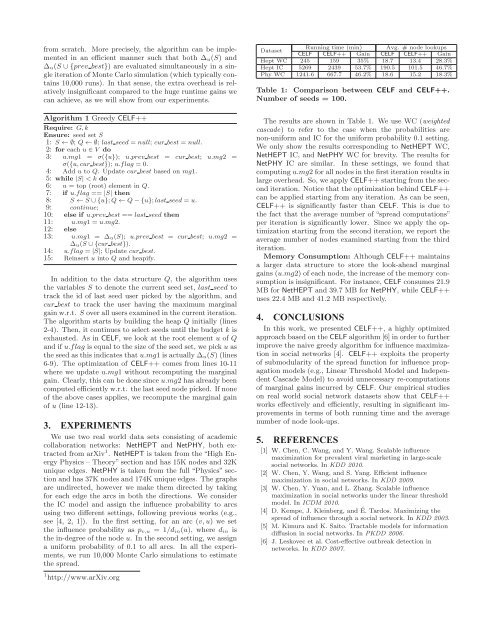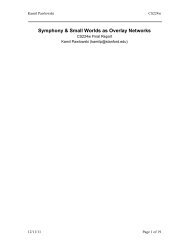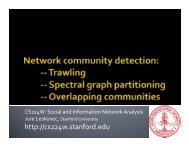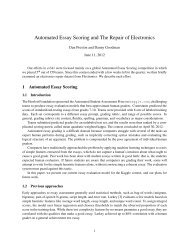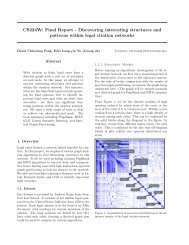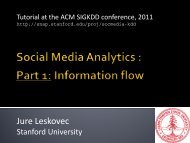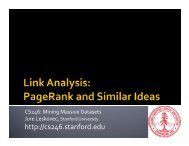CELF++: Optimizing the Greedy Algorithm for Influence ...
CELF++: Optimizing the Greedy Algorithm for Influence ...
CELF++: Optimizing the Greedy Algorithm for Influence ...
You also want an ePaper? Increase the reach of your titles
YUMPU automatically turns print PDFs into web optimized ePapers that Google loves.
from scratch. More precisely, <strong>the</strong> algorithm can be implemented<br />
in an efficient manner such that both ∆u(S) and<br />
∆u(S ∪{prev best}) are evaluated simultaneously in a single<br />
iteration of Monte Carlo simulation (which typically contains<br />
10,000 runs). In that sense, <strong>the</strong> extra overhead is relatively<br />
insignificant compared to <strong>the</strong> huge runtime gains we<br />
can achieve, as we will show from our experiments.<br />
<strong>Algorithm</strong> 1 <strong>Greedy</strong> <strong>CELF++</strong><br />
Require: G,k<br />
Ensure: seed set S<br />
1: S ← ∅; Q ← ∅; last seed = null; cur best = null.<br />
2: <strong>for</strong> each u ∈ V do<br />
3: u.mg1 = σ({u}); u.prev best = cur best; u.mg2 =<br />
σ({u,cur best}); u.flag = 0.<br />
4: Add u to Q. Update cur best based on mg1.<br />
5: while |S| < k do<br />
6: u = top (root) element in Q.<br />
7: if u.flag == |S| <strong>the</strong>n<br />
8: S ← S ∪{u};Q ← Q−{u};last seed = u.<br />
9: continue;<br />
10: else if u.prev best == last seed <strong>the</strong>n<br />
11: u.mg1 = u.mg2.<br />
12: else<br />
13: u.mg1 = ∆u(S); u.prev best = cur best; u.mg2 =<br />
∆u(S ∪{cur best}).<br />
14: u.flag = |S|; Update cur best.<br />
15: Reinsert u into Q and heapify.<br />
In addition to <strong>the</strong> data structure Q, <strong>the</strong> algorithm uses<br />
<strong>the</strong> variables S to denote <strong>the</strong> current seed set, last seed to<br />
track <strong>the</strong> id of last seed user picked by <strong>the</strong> algorithm, and<br />
cur best to track <strong>the</strong> user having <strong>the</strong> maximum marginal<br />
gainw.r.t. S overallusersexaminedin<strong>the</strong>currentiteration.<br />
The algorithm starts by building <strong>the</strong> heap Q initially (lines<br />
2-4). Then, it continues to select seeds until <strong>the</strong> budget k is<br />
exhausted. As in CELF, we look at <strong>the</strong> root element u of Q<br />
and if u.flag is equal to <strong>the</strong> size of <strong>the</strong> seed set, we pick u as<br />
<strong>the</strong> seed as this indicates that u.mg1 is actually ∆u(S) (lines<br />
6-9). The optimization of <strong>CELF++</strong> comes from lines 10-11<br />
where we update u.mg1 without recomputing <strong>the</strong> marginal<br />
gain. Clearly, this can be done since u.mg2 has already been<br />
computed efficiently w.r.t. <strong>the</strong> last seed node picked. If none<br />
of <strong>the</strong> above cases applies, we recompute <strong>the</strong> marginal gain<br />
of u (line 12-13).<br />
3. EXPERIMENTS<br />
We use two real world data sets consisting of academic<br />
collaboration networks: NetHEPT and NetPHY, both extracted<br />
from arXiv 1 . NetHEPT is taken from <strong>the</strong>“High Energy<br />
Physics – Theory”section and has 15K nodes and 32K<br />
unique edges. NetPHY is taken from <strong>the</strong> full“Physics”section<br />
and has 37K nodes and 174K unique edges. The graphs<br />
are undirected, however we make <strong>the</strong>m directed by taking<br />
<strong>for</strong> each edge <strong>the</strong> arcs in both <strong>the</strong> directions. We consider<br />
<strong>the</strong> IC model and assign <strong>the</strong> influence probability to arcs<br />
using two different settings, following previous works (e.g.,<br />
see [4, 2, 1]). In <strong>the</strong> first setting, <strong>for</strong> an arc (v,u) we set<br />
<strong>the</strong> influence probability as pv,u = 1/din(u), where din is<br />
<strong>the</strong> in-degree of <strong>the</strong> node u. In <strong>the</strong> second setting, we assign<br />
a uni<strong>for</strong>m probability of 0.1 to all arcs. In all <strong>the</strong> experiments,<br />
we run 10,000 Monte Carlo simulations to estimate<br />
<strong>the</strong> spread.<br />
1 http://www.arXiv.org<br />
Dataset<br />
Running time (min)<br />
CELF <strong>CELF++</strong> Gain<br />
Avg. # node lookups<br />
CELF <strong>CELF++</strong> Gain<br />
Hept WC 245 159 35% 18.7 13.4 28.3%<br />
Hept IC 5269 2439 53.7% 190.5 101.5 46.7%<br />
Phy WC 1241.6 667.7 46.2% 18.6 15.2 18.3%<br />
Table 1: Comparison between CELF and <strong>CELF++</strong>.<br />
Number of seeds = 100.<br />
The results are shown in Table 1. We use WC (weighted<br />
cascade) to refer to <strong>the</strong> case when <strong>the</strong> probabilities are<br />
non-uni<strong>for</strong>m and IC <strong>for</strong> <strong>the</strong> uni<strong>for</strong>m probability 0.1 setting.<br />
We only show <strong>the</strong> results corresponding to NetHEPT WC,<br />
NetHEPT IC, and NetPHY WC <strong>for</strong> brevity. The results <strong>for</strong><br />
NetPHY IC are similar. In <strong>the</strong>se settings, we found that<br />
computing u.mg2 <strong>for</strong> all nodes in <strong>the</strong> first iteration results in<br />
large overhead. So, we apply <strong>CELF++</strong> starting from <strong>the</strong> second<br />
iteration. Notice that <strong>the</strong> optimization behind <strong>CELF++</strong><br />
can be applied starting from any iteration. As can be seen,<br />
<strong>CELF++</strong> is significantly faster than CELF. This is due to<br />
<strong>the</strong> fact that <strong>the</strong> average number of“spread computations”<br />
per iteration is significantly lower. Since we apply <strong>the</strong> optimization<br />
starting from <strong>the</strong> second iteration, we report <strong>the</strong><br />
average number of nodes examined starting from <strong>the</strong> third<br />
iteration.<br />
Memory Consumption: Although <strong>CELF++</strong> maintains<br />
a larger data structure to store <strong>the</strong> look-ahead marginal<br />
gains (u.mg2) of each node, <strong>the</strong> increase of <strong>the</strong> memory consumption<br />
is insignificant. For instance, CELF consumes 21.9<br />
MB <strong>for</strong> NetHEPT and 39.7 MB <strong>for</strong> NetPHY, while <strong>CELF++</strong><br />
uses 22.4 MB and 41.2 MB respectively.<br />
4. CONCLUSIONS<br />
In this work, we presented <strong>CELF++</strong>, a highly optimized<br />
approachbasedon<strong>the</strong>CELFalgorithm[6]inordertofur<strong>the</strong>r<br />
improve <strong>the</strong> naive greedy algorithm <strong>for</strong> influence maximization<br />
in social networks [4]. <strong>CELF++</strong> exploits <strong>the</strong> property<br />
of submodularity of <strong>the</strong> spread function <strong>for</strong> influence propagation<br />
models (e.g., Linear Threshold Model and Independent<br />
Cascade Model) to avoid unnecessary re-computations<br />
of marginal gains incurred by CELF. Our empirical studies<br />
on real world social network datasets show that <strong>CELF++</strong><br />
works effectively and efficiently, resulting in significant improvements<br />
in terms of both running time and <strong>the</strong> average<br />
number of node look-ups.<br />
5. REFERENCES<br />
[1] W. Chen, C. Wang, and Y. Wang. Scalable influence<br />
maximization <strong>for</strong> prevalent viral marketing in large-scale<br />
social networks. In KDD 2010.<br />
[2] W. Chen, Y. Wang, and S. Yang. Efficient influence<br />
maximization in social networks. In KDD 2009.<br />
[3] W. Chen, Y. Yuan, and L. Zhang. Scalable influence<br />
maximization in social networks under <strong>the</strong> linear threshold<br />
model. In ICDM 2010.<br />
[4] D. Kempe, J. Kleinberg, and É. Tardos. Maximizing <strong>the</strong><br />
spread of influence through a social network. In KDD 2003.<br />
[5] M. Kimura and K. Saito. Tractable models <strong>for</strong> in<strong>for</strong>mation<br />
diffusion in social networks. In PKDD 2006.<br />
[6] J. Leskovec et al. Cost-effective outbreak detection in<br />
networks. In KDD 2007.


